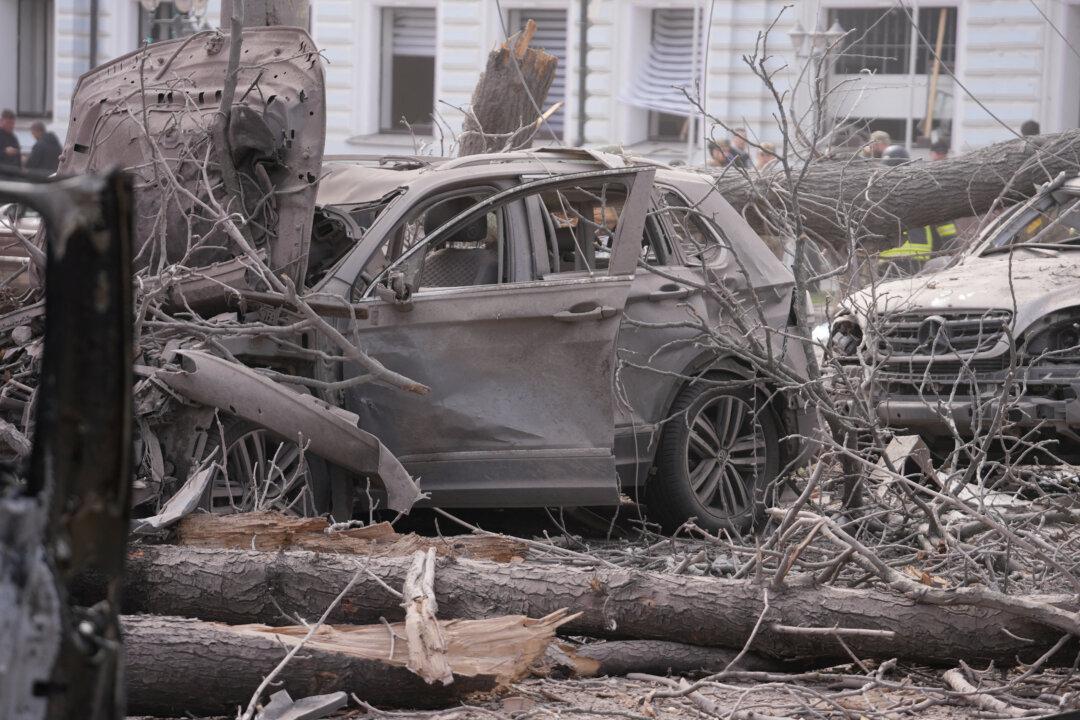Fighting between Russian and Ukrainian forces this week centered largely around the southern Ukrainian region of Kherson, where both sides claim to have registered significant gains.
On Oct. 20, the Ukrainian military—usually tight-lipped about ongoing operations—said dozens of Russian troops had been killed and several Russian tanks destroyed in its latest attempt to breach Russian defenses in Kherson.
One day earlier, however, Russia’s TASS news agency reported that Ukraine’s offensive in Kherson had been decisively repelled.
“The situation in Kherson is under full control,” Kirill Stremousov, the region’s pro-Russian deputy governor, was quoted as saying. “Our forces have not moved back an inch.”
According to the Russian Defense Ministry, more than 90 Ukrainian troops and nine combat vehicles were “eliminated” by Russian artillery fire during attempts by Ukrainian forces to penetrate Russian lines.
The Epoch Times couldn’t verify claims made by either side.
The Kherson region, along with the regions of Donetsk, Luhansk, and Zaporizhzhia, were incorporated into the Russian Federation late last month following referendums in all four territories.
Kyiv and its allies reject the referendum results and view the four regions as having been illegally annexed by Russia. Ukrainian leaders have repeatedly vowed to recover all four territories by force of arms.
Of the four regions, Kherson is considered the most strategically significant since it commands the only land route to the Crimean Peninsula, along with the mouth of the Dnieper River.
Most of Kherson, including its regional capital, was captured by Russia and its local allies in the first weeks of Moscow’s “special military operation” in Ukraine, which began almost eight months ago.
Earlier this week, Kherson’s pro-Russian governor said civilians in the combat zone would be evacuated to the west bank of the Dnieper in anticipation of further attacks by Ukrainian forces, which, he said, were largely concentrated in the Mykolaiv and Kryvyi Rih areas.
After registering significant gains in the northeastern Kharkiv region last month, Ukrainian forces have continued to carry out limited counter-offensives along both the southern and eastern fronts, where they have run up against stiff Russian resistance.
Ukrainian offensive operations will likely be hindered by the onset of autumn, which is typically accompanied by heavy rainfall, according to military experts.
In a related development, the Russian air force has begun carrying out scheduled patrol flights along the borders of Belarus, a close ally of Moscow, officials in Minsk said on Oct. 20.
Last week, Russia began dispatching thousands of troops and military hardware to Belarus, Ukraine’s immediate neighbor to the north.
The fact that Kyiv sits only 150 kilometers (93 miles) from the Belarusian border has prompted speculation that Russian troops dispatched to Belarus could be used in a future assault on the Ukrainian capital.

EU ‘Party to Conflict’
Ukraine’s Western allies, meanwhile, continue to pledge stepped-up support for Kyiv amid ongoing artillery and drone strikes by Russia that have crippled the country’s energy infrastructure.On Oct. 20, German Chancellor Olaf Scholz said his country planned to train up to 5,000 Ukrainian troops within the framework of a European Union training initiative.
Approved by Brussels earlier this week, the two-year program seeks to train a total of 15,000 Ukrainian military personnel at training sites in Poland and Germany.
“By spring, we will train a complete brigade of up to 5,000 soldiers,” Scholz told lawmakers in Berlin.
“With this, we are underlining our readiness to participate in the long-term building of strong Ukrainian armed forces, hand in hand with our partners.”
Responding to the German chancellor’s statements, Russian Foreign Ministry spokeswoman Maria Zakharova said the move—if carried out—would effectively make the European Union “a party to the conflict.”
Meanwhile, Russia has continued to carry out artillery and drone strikes against energy infrastructure deep inside Ukrainian territory.
According to officials in Kyiv, roughly 30 percent of Ukraine’s power stations have been knocked out since Oct. 10, causing major power disruptions throughout the country.
“There is new damage to critical infrastructure,” Ukrainian President Volodymyr Zelenskyy said in an evening address on Oct. 19. “Three energy facilities were destroyed by the enemy today.”
The Russian Defense Ministry’s daily briefing for Oct. 19 appeared to confirm Zelenskyy’s assertions.
“In the past 24 hours, the Russian Armed Forces have continued launching attacks by high-precision, long-range air- and sea-based armaments at the military control and energy systems of Ukraine,” the briefing read.
“All the assigned targets have been neutralized.”
Intermittent fighting continues in all four regions, especially in the form of artillery exchanges, although battlefield reports are almost impossible to verify.
Both sides frequently accuse the other of striking civilian targets.
On Oct. 20, TASS, citing pro-Russian sources in Luhansk, reported that more than 100 civilians had been killed in the region by Ukrainian artillery fire since the conflict began on Feb. 24.





